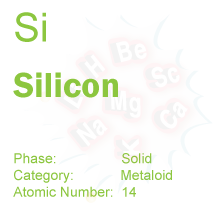 Periodic Table -> Silicon
Periodic Table -> SiliconSilicon
Silicon DetailsSilicon Symbol: Si
Silicon Atomic Number: 14
Silicon Atomic Weight: 28.086
What is Silicon?
Silicon (atomic number 14, symbol Si) is a metalloid and a chemical element which is solid at room temperature. It was isolated in 1824 by the Swedish chemist Jons Berzelius who also identified elements such as cerium, thorium, and selenium. Silicon is one of the most abundant elements in the universe, together with helium, hydrogen, carbon, nitrogen, neon, and oxygen. It is one of the most abundant elements in the earth's crust as well, along with calcium, iron, aluminum, and oxygen.
Properties and Occurrence
This is a brittle, electropositive element with a boiling point of 3265 C (5909 F). Silicon has two known allotropes –crystalline and amorphous with relatively high boiling and melting points. It is lustrous and gray in color. Common oxidation states are -4, -3, -2, -1, 1, 2, 3, and 4. Silicon forms a number of compounds, including silatranes, tetrahalides, disilenes, silane, and others. Si-30, Si-29, and Si-28 are stable isotopes. The isotopes are 5 in total. Silicon forms when crystals are doped with arsenic, phosphorus, germanium, gallium, and potassium. The Czochralski process is used to grow crystals. The major producers are the United States, Russia, and China. Pure silicon occurs in different minerals, including opal, jasper, rock crystal, agate amethyst, and quartz while amorphous opaline or biogenic silica can be found in siliceous sponges and diatoms. Silicates and silica are abundant and non-toxic. Minerals are also mined, including kaolinite, perlite, vermiculite, and olivine. Some types of silica are rare and expensive. Examples include microcrystallines and diamond stimulants such as rhinestone, agate, gemstone opal, and others.
Applications
Silicon has application in electronics and alloys in the steel industry. It is added to alloys to reduce cracks and tearing. The element is also used to produce semiconductor devices and detectors, photovoltaic applications, and wafers. Its compounds also have commercial applications. Sodium silicate, for example, is used as an egg preservative and added to adhesives and soaps. It is also added to silicon which is used for implants, insulators, polishing agents, and lubricants. Silicon has many applications in the food and chemical industries. For example, silicon oils are added to different foods and beverages because of their chemical inertness, thermal stability, and water insolubility. Lubricating oils and antifoaming agents are used in food processing and production. Silicon dioxide is used to produce microelements, structured materials, defoamer components, and aerogels. In addition, silica is a fining agent which is added to juices, beer, and wine.

Silicon dioxide is used in beauty products, thermal protection fabrics, and cement. It is mostly used in construction and added to bottles, optical fibers, glasses, and porcelain. Silicone is added to cleaning solutions, fabric coatings, hydrophobic finishes, and fabric softeners. It is also used in the paper and pulp industries, electronics industry, adhesives, mold making, and the construction industry. Finally, silicones are used in structural glazing, sealing, and sanitary joints as sealants. They are added to coatings, high-temperature paints, as well as weather-resistant paints.
Health Effects
Silicon is found in the skin and connective tissue. It is non-toxic but may cause respiratory problems. Some of its compounds, for example, silicon dioxide are considered a health hazard. It is found in aerogels, silica gels, fumed silica, and fused quartz. Long-term exposure to cristobalite and quartz increases the risk for lung cancer. Refractory brick workers, pottery and granite workers, and miners are also at risk. Overexposure can lead to chronic conditions and autoimmune disorders, including sarcoidosis, systemic lupus erythematosus, rheumatoid arthritis, and scleroderma. Long-term exposure to silica also leads to fungal and bacterial infections and renal diseases. Inhalation increases the risk for emphysema, obstructive pulmonary disease, and bronchitis. These effects are more common in tobacco users and smokers. Skin inflammations have been reported as well, including side effects such as itching, scaling, and reddening. In general, side effects are uncommon when exposure is kept within normal limits.
You can
link to this page, using the code below:
Periodic Table |
Banks
© ElementsDatabase.com 2015 | Privacy | About | Contact